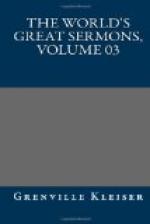The dark and seemingly ambiguous method of conveying important discoveries under figures and emblems was not peculiar to the sacred books. The spirit of God in presignifying the death of Christ, adopted that plan, according to which the whole knowledge of those early ages was propagated through the world. Under the veil of mysterious allusion, all wisdom was then concealed. From the sensible world images were everywhere borrowed to describe things unseen. More was understood to be meant than was openly exprest. By enigmatical rites the priests communicated his doctrines; by parables and allegories the philosopher instructed his disciples; even the legislator, by figurative sayings, commanded the reverence of the people. Agreeably to this prevailing mode of instruction, the whole dispensation of the Old Testament was so conducted as to be the shadow and figure of a spiritual system. Every remarkable event, every distinguished personage, under the law, is interpreted in the New Testament, as bearing reference to the hour of which we treat. If Isaac was laid upon the altar as an innocent victim; if David was driven from his throne by the wicked, and restored by the hand of God; if the brazen serpent was lifted up to heal the people; if the rock was smitten by Moses, to furnish drink in the wilderness; all were types of Christ and alluded to His death.
In predicting the same event the language of ancient prophecy was magnificent, but seemingly contradictory: for it foretold a Messiah, who was to be at once a sufferer and a conquerer. The Star was to come out of Jacob, and the Branch to spring from the stem of Jesse. The Angel of the Covenant, the desire of all nations, was to come suddenly to His temple; and to Him was to be “the gathering of the people.” Yet, at the same time, He was to be “despised and rejected of men”; He was to be “taken from prison and from judgment,” and to be “led as a lamb to the slaughter.” Tho He was “a man of sorrows, and acquainted with grief,” yet “the Gentiles were to come to his light, and kings to the brightness of his rising.” In the hour when Christ died, those prophetical riddles were solved: those seeming contradictions were reconciled. The obscurity of oracles, and the ambiguity of typos vanished. The “sun of righteousness” rose; and, together with the dawn of religion those shadows passed away.




